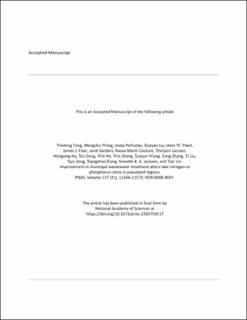| dc.contributor.author | Tong, Yindong | |
| dc.contributor.author | Wang, Mengzhu | |
| dc.contributor.author | Peñuelas, Josep | |
| dc.contributor.author | Liu, Xueyan | |
| dc.contributor.author | Paerl, Hans W. | |
| dc.contributor.author | Elser, James J. | |
| dc.contributor.author | Sardans, Jordi | |
| dc.contributor.author | Couture, Raoul-Marie | |
| dc.contributor.author | Larssen, Thorjørn | |
| dc.contributor.author | Hu, Hongying | |
| dc.contributor.author | Dong, Xin | |
| dc.contributor.author | He, Wei | |
| dc.contributor.author | Zhang, Wei | |
| dc.contributor.author | Wang, Xuejun | |
| dc.contributor.author | Zhang, Yang | |
| dc.contributor.author | Liu, Yi | |
| dc.contributor.author | Zeng, Siyu | |
| dc.contributor.author | Kong, Xiangzhen | |
| dc.contributor.author | Janssen, Annette B.G. | |
| dc.contributor.author | Lin, Yan | |
| dc.date.accessioned | 2020-09-30T06:44:58Z | |
| dc.date.available | 2020-09-30T06:44:58Z | |
| dc.date.created | 2020-09-04T11:03:30Z | |
| dc.date.issued | 2020 | |
| dc.identifier.citation | Proceedings of the National Academy of Sciences of the United States of America. 2020, 117 (21), 11566-11572. | en_US |
| dc.identifier.issn | 0027-8424 | |
| dc.identifier.uri | https://hdl.handle.net/11250/2680401 | |
| dc.description | Embargo until 26 Nov 2020 | en_US |
| dc.description.abstract | Large-scale and rapid improvement in wastewater treatment is common practice in developing countries, yet this influence on nutrient regimes in receiving waterbodies is rarely examined at broad spatial and temporal scales. Here, we present a study linking decadal nutrient monitoring data in lakes with the corresponding estimates of five major anthropogenic nutrient discharges in their surrounding watersheds over time. Within a continuous monitoring dataset covering the period 2008 to 2017, we find that due to different rates of change in TN and TP concentrations, 24 of 46 lakes, mostly located in China’s populated regions, showed increasing TN/TP mass ratios; only 3 lakes showed a decrease. Quantitative relationships between in-lake nutrient concentrations (and their ratios) and anthropogenic nutrient discharges in the surrounding watersheds indicate that increase of lake TN/TP ratios is associated with the rapid improvement in municipal wastewater treatment. Due to the higher removal efficiency of TP compared with TN, TN/TP mass ratios in total municipal wastewater discharge have continued to increase from a median of 10.7 (95% confidence interval, 7.6 to 15.1) in 2008 to 17.7 (95% confidence interval, 13.2 to 27.2) in 2017. Improving municipal wastewater collection and treatment worldwide is an important target within the 17 sustainable development goals set by the United Nations. Given potential ecological impacts on biodiversity and ecosystem function of altered nutrient ratios in wastewater discharge, our results suggest that long-term strategies for domestic wastewater management should not merely focus on total reductions of nutrient discharges but also consider their stoichiometric balance. | en_US |
| dc.language.iso | eng | en_US |
| dc.publisher | National Academy of Sciences | en_US |
| dc.title | Improvement in municipal wastewater treatment alters lake nitrogen to phosphorus ratios in populated regions | en_US |
| dc.type | Peer reviewed | en_US |
| dc.type | Journal article | en_US |
| dc.description.version | acceptedVersion | en_US |
| dc.source.pagenumber | 11566-11572 | en_US |
| dc.source.volume | 117 | en_US |
| dc.source.journal | Proceedings of the National Academy of Sciences of the United States of America | en_US |
| dc.source.issue | 21 | en_US |
| dc.identifier.doi | 10.1073/pnas.1920759117 | |
| dc.identifier.cristin | 1827323 | |
| cristin.ispublished | true | |
| cristin.fulltext | postprint | |
| cristin.qualitycode | 2 | |
